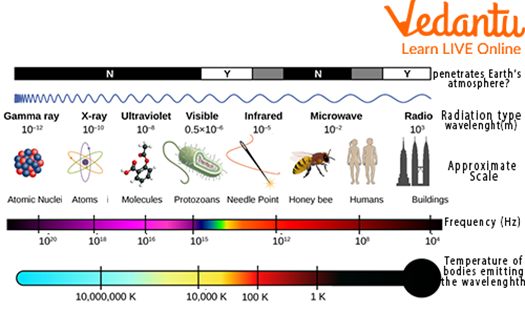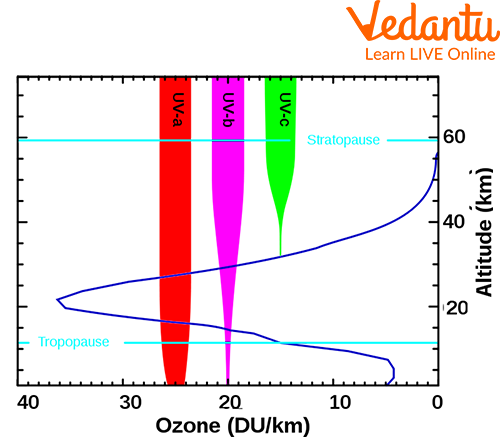




Ultraviolet Rays Definition
Ultraviolet rays are a type of electromagnetic radiation that has a wavelength shorter than visible light. They are invisible to human eyes, but they can be seen by cameras and other devices if they are given proper filters. Ultraviolet rays are the cause of sunburn and skin cancer.

Ultraviolet Rays
As we go out in the sun, ultraviolet rays penetrate our skin more deeply than visible light because their wavelengths are shorter. Because they have higher energy levels, ultraviolet rays can damage the DNA in cells more easily than visible light, which is less energetic and cannot penetrate as deeply into the skin.
What are Ultraviolet Rays?

Electromagnetic Waves of Various Rays
Ultraviolet rays are electromagnetic waves that have a wavelength shorter than visible light but longer than X-rays. Ultraviolet rays are invisible to the human eye but can be seen by animals with sensitive eyes, such as cats, dogs, and some birds.
Ultraviolet rays are a type of electromagnetic radiation. Ultraviolet rays are not visible to the naked eye because they are shorter than violet light. It is a type of ionizing radiation and it has properties that can damage cells and cause cancer.

UV rays classification as A,B,C
Classification of Ultraviolet Rays
Ultraviolet rays are classified as UVA, UVB, or UVC based on their wavelengths.
UVA
These waves have a wavelength ranging from 315 to 399 nm. The rays are not absorbed by the ozone layer.
UVB
These rays have a wavelength ranging from 280 to 314 nm. Part of these rays does reach the Earth's surface but is primarily absorbed by the ozone layer
UVC
These waves have a wavelength ranging from 100 to 279 nm. These types of ultraviolet rays are completely absorbed by the atmosphere and ozone layer
Uses of Ultraviolet Rays
The uses of ultraviolet Rays are as follows:
UV rays are used in tanning booths where our body is exposed to UV radiation, and our body produces melanin, making our skin darker. Tanning booths use artificial UV light in lamps which are used to tan the skin.
UV rays are used to analyze the chemical structure of a compound via colour changes. A machine is called a spectrophotometer, a machine which is used to analyze a compound's chemical structure through the change in colour. This is often used in water laboratories, biological plants and in the petrochemical industry.
UV rays are also used to produce polyphenols, which are a plant that is said to be helpful in the prevention of cancer. Patients are given a drug called psoralens, which reacts to UVA light treatment.
UV rays are also used in medicinal treatment, that is treating cancer. They are helpful in killing the tumour cells in the human body.
Application of UV Rays
UV rays are used to detect fake currency notes. Currency notes are exposed to UV radiations and the authentic UV marks are verified through the radiations.
UV radiation, also called black light, is used to photograph fingerprints. UV rays with the help of fluorescent powders or solutions are used as a spray or immersion to find fingerprints.
UV rays are also used to kill harmful bacteria from the water with the help of water purifiers.
Examples of Ultraviolet Rays
Some examples of ultraviolet rays are:
The sun’s ultraviolet waves produce the ozone layer in the atmosphere by reacting with oxygen and nitrogen gases.
UVB waves can cause sunburns and skin cancer if they reach the skin directly, or indirectly through water or snow.
UV light can cause skin cancer, cataracts and sunburns. It also damages DNA in cells and can lead to premature ageing or skin wrinkling.
UV radiation from sunlight is blocked by window glass, so people cannot get sunburned through their windows.
Applications of Ultraviolet Rays in the Medical Field
Some of the applications of ultraviolet rays include:
Ultraviolet rays can be dangerous but they can also be used in the medical field to treat skin conditions such as psoriasis, vitiligo and eczema.
Ultraviolet rays have been used in the medical field for a while now, but they are still not used as much as they should be.
Some of the most popular uses of ultraviolet rays in the medical field are:
Sunburns
Acne treatment
Psoriasis treatment
Treating skin cancer
Treating vitiligo
Ultraviolet rays have many applications in the medical field. It is used for sterilising, disinfecting, and killing bacteria and viruses in a person's body. It is also used to treat skin conditions like acne, eczema, psoriasis and vitiligo.
Summary
In this article, we have learned that UV rays are electromagnetic waves with a wavelength shorter than visible light. The sun emits UV rays that can cause skin cancer and eye damage. The first thing to note is that the sun emits ultraviolet rays, which are classified as electromagnetic waves with wavelengths shorter than visible light.
We also learned that these waves can cause skin cancer and eye damage because they have the potential to penetrate deep into the tissues of your skin and eyes. We read about UV rays in this article. We discussed its applications and uses in detail. We hope you enjoyed reading this article, in case of any other doubts, feel free to ask in the comments.
FAQs on Uses of Ultraviolet Rays
1. What can block ultraviolet rays?
To protect yourself from UV radiation, wear a wide-brimmed hat to shade your face, head, ears, and neck. Use sunscreen with SPF15 or higher.
2. Which UV rays are most harmful?
Short-wavelength UVC is the most damaging type of UV radiation.
3. Which type of UV ray does not reach the earth?
UVC radiation from the sun does not reach the earth's surface because it is blocked by the ozone layer in the atmosphere.









